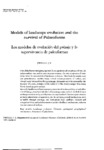Models of landscape evolution and the survival of Palaeoforms

View/
Use this link to cite
http://hdl.handle.net/2183/6275Collections
Metadata
Show full item recordTitle
Models of landscape evolution and the survival of PalaeoformsAlternative Title(s)
Los modelos de evolución del paisaje y la supervivencia de paleoformasAuthor(s)
Date
1997Citation
Cadernos do Laboratorio Xeolóxico de Laxe, 1997, 22: 151-182 ISSN: 0213-4497
Abstract
[Abstract] Qne ofthe factots rnitigating against the recognition and acceptance ofvery old palaeosurfaces was, and in sorne rneasure rernains, the tacit acceptance ofsorne ofthe better known rnodels oflandscape evolution. Thus both the steady state and peneplanation rnodels irnply virtual conternporaneity of surface, and though scarp retreat allows for a greater age, the rnaxirnurn is deterrnined by the duration of a cycle, probably of the order of 33 Ma; rnuch younger than rnany fitrnly dated epigene surfaces. Basically landforrn and landscape persistence involves the stability, or only slow rate ofchange, ofsurfaces (divides) ofbounding scarps, or both. Such slow rates ofchange are induced by such factors as resistant bedrock: hence the preservation of rnany palaeoforrns on quartzites, etc. In addition, several rnechanisrns, such as uplift, through drainage, and consequent local «aridity>,; incision and unequal activity; and reinforcernent or positive feedback rnechanisrns, enhance the persistence of surfaces.
Keywords
Landscape evolution
Climatic
Geological
Geographical mechanisms
Persistence of paleoforms
Climatic
Geological
Geographical mechanisms
Persistence of paleoforms
ISSN
0213-4497





